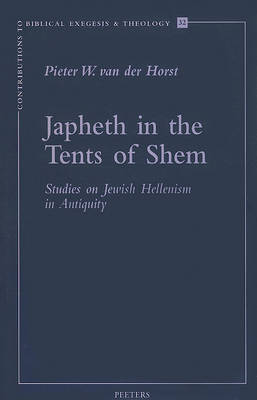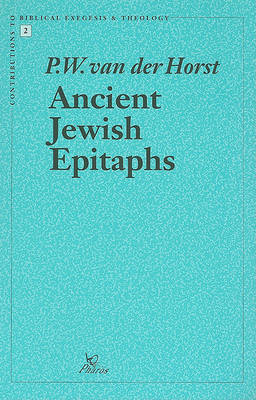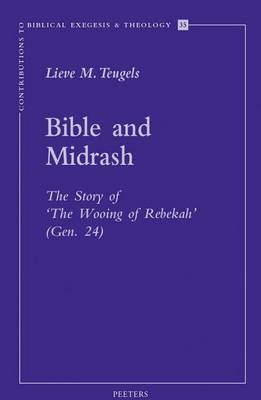Contributions to Biblical Exegesis & Theology
4 total works
v.32
In rabbinic parlance, A"Japheth in the tents of ShemA" (Genesis 9:27) has become a proverbial expression for the interaction between Greek and Jewish cultures. The present volume contains 15 studies exploring a wide variety of aspects of the meeting of these cultures in antiquity. In the past 30 years the manifold manifestations of 'Jewish Hellenism' have become the focus of intensive research. The author of this book has played an active part in this field and the essays presented here are the fruits of his most recent research.
He investigates, among other things, the extent to which Greek had become the daily language of the Jews (and the Samaritans) in Hellenistic and Roman Palestine; the knowledge of Greek medical lore and science among the rabbis; the development of Greek forms of the synagogal Eighteen Benedictions; the Jewish participation in the Hellenistic-Roman debate about antediluvian knowledge ('wisdom from before the flood'); the background of the surprising phenomenon of voluntary celibacy among ancient Jews; the role of the veneration of the tombs of biblical prophets in Jewish popular religion; the work of the Judaeo-Greek alchemist Maria, who happens to be the first female Jewish author we know of; the life and works of the most notorious anti-Semite from pagan antiquity, Apion, and Josephus' response to him; the Samaritan diaspora in Rome; the attractiveness of Judaism for Christians; et multa cetera. Pieter W. van der Horst (1946) is professor of New Testament and of the Jewish and Hellenistic world of early Christianity at the Faculty of Theology of Utrecht University.
He published some 250 articles and books in the fields of early Judaism, ancient Christianity, and Graeco-Roman culture, with a special emphasis on their interactions. He is a member of the Royal Netherlands Academy of Arts and Sciences.
He investigates, among other things, the extent to which Greek had become the daily language of the Jews (and the Samaritans) in Hellenistic and Roman Palestine; the knowledge of Greek medical lore and science among the rabbis; the development of Greek forms of the synagogal Eighteen Benedictions; the Jewish participation in the Hellenistic-Roman debate about antediluvian knowledge ('wisdom from before the flood'); the background of the surprising phenomenon of voluntary celibacy among ancient Jews; the role of the veneration of the tombs of biblical prophets in Jewish popular religion; the work of the Judaeo-Greek alchemist Maria, who happens to be the first female Jewish author we know of; the life and works of the most notorious anti-Semite from pagan antiquity, Apion, and Josephus' response to him; the Samaritan diaspora in Rome; the attractiveness of Judaism for Christians; et multa cetera. Pieter W. van der Horst (1946) is professor of New Testament and of the Jewish and Hellenistic world of early Christianity at the Faculty of Theology of Utrecht University.
He published some 250 articles and books in the fields of early Judaism, ancient Christianity, and Graeco-Roman culture, with a special emphasis on their interactions. He is a member of the Royal Netherlands Academy of Arts and Sciences.
v.2
v.22
The Use of Sacred Books in the Ancient World
by L. V. Rutgers, Lieve Teugels, Henriette W. Havelaar, and Pieter W. van der Horst
Published 1 January 1998
In this volume a number of scholars from Israel, the USA, and England have joined forces with the well-known Utrecht University Research Unit "The Cultural Milieu of Early Christianity" to investigate in an unprecendently interdisciplinary fashion how sacred books functioned in pagan, Jewish, and Christian circles. The 16 essays cover a wide range of topics including a discussion of emergence of canonical scriptures in late antiquity, an investigation of parallels between exegesis of Homer by the Greeks and that of the Bible by the Jews, a study of the rise of Virgil's Aeneid to the status of "canonical" book; a discussion of the use of sacred books as instant oracles; an investigation of the role of the Bible in polemics between Jews and Christians; an analysis of the wide variety of quotation formula's used by New Testament authors, a discussion of the role of biblical interpretation in the thought world of Jesus' brother, James; an investigation of the function of Scripture in the midrash Aggadat Bereshit, and other topics.
v.35
Lesage n'a pas ecrit une "Histoire de Gil Blas", mais trois, qui se completent a dix puis vingt ans de distance. Les auteurs de ce volume ont fait le pari qu'on pouvait lire separement la premiere, celle de 1715. Ils ont voulu rendre compte de l'hesitation des critiques devant un des rares romans du 18e siecle a etre reste populaire: en reperant ce qui autorise des lectures contradictoires, jeu de defausse ou suspension indefinie du sens, mais aussi en retrouvant les intentions litteraires de cette ecriture avec la notion de sublime comique ou d'ingeniosite postcritique. Ce projet historique dans sa visee a donc une ambition poetique: les interpretations de Gil Blas ici proposees sont une contribution a la reconnaissance des proprietes du roman d'Ancien Regime et une quete des outils critiques qui leur sont adaptes.Les travaux de ce volume ont d'abord ete presentes lors de deux journees d'etudes, l'une tenue en decembre 2002 a l'universite de Paris 3-Sorbonne nouvelle et organisee par le Cerlav 18, en collaboration avec les collegues de l'universite de Grenoble, et la seconde en janvier 2003 a l'ENS de la rue d'Ulm.
Y ont ete joints deux textes inedits de Rene Demoris et de Marc Escola.
Y ont ete joints deux textes inedits de Rene Demoris et de Marc Escola.



